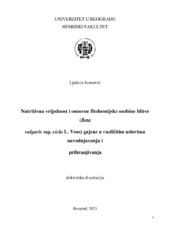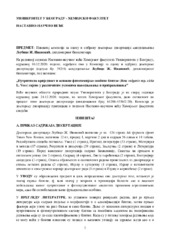Приказ основних података о дисертацији
Nutritivna vrijednost i osnovne fitohemijske osobine blitve (Beta vulgaris ssp. cicla L. Voss) gajene u različitim uslovima navodnjavanja i prihranjivanja
Nutritive and phytochemical properties of Swiss chard (Beta vulgaris ssp. cicla L. Voss) grown under different irrigation and fertilization regimes
| dc.contributor.advisor | Beškoski, Vladimir | |
| dc.contributor.other | Tešević, Vele | |
| dc.contributor.other | Đurović, Dijana | |
| dc.contributor.other | Bogdanović, Višnja | |
| dc.contributor.other | Stanojević, Slađana | |
| dc.creator | Ivanović, Ljubica | |
| dc.date.accessioned | 2023-11-28T17:20:53Z | |
| dc.date.available | 2023-11-28T17:20:53Z | |
| dc.date.issued | 2023-05-09 | |
| dc.identifier.uri | https://eteze.bg.ac.rs/application/showtheses?thesesId=9369 | |
| dc.identifier.uri | https://fedorabg.bg.ac.rs/fedora/get/o:31816/bdef:Content/download | |
| dc.identifier.uri | https://plus.cobiss.net/cobiss/sr/sr/bib/130986249 | |
| dc.identifier.uri | https://nardus.mpn.gov.rs/handle/123456789/21930 | |
| dc.description.abstract | U okviru ove doktorske disertacije proučavan je nutritivni i fitonutritivni sadržaj blitve koja je gajena u uslovima različitih režima đubrenja i navodnjavanja, pri čemu su ispitivane i funkcionalne osobine blitve u cilju utvrđivanja njenog potencijala kao funkcionalne hrane. U početnoj fazi eksperimenta određene su nutritivne, antinutritivne i fitonutritivne komponente u blitvi, kao i uticaj primjenjenih agrotehničkih mjera na pomenute komponente. Korišćenjem standardnih metoda za proksimativnu analizu (AOAC metode) utvrđeno je da svježa blitva ima sledeći sastav: voda- 89%, ukupni šećeri- 4,9%, proteini- 2,5%, pepeo- 1,8% i lipidi-0,45%. Savremenim instrumentalnim tehnikama (spektrofotometrija, ICP OES, tečna hromatografija) su kvantifikovane druge nutritivne, antinutritivne i fitonutritivne komponente u blitvi. Nađeno je da su prosječne koncentracije vitamina C, ukupnog hlorofila, karotenoida u 100 g svježe blitve su redom: 26,9 mg, 47,13 mg, 9,85 mg. Blitva ima visok sadržaj makro- i mikroelemenata od kojih su najzastupljeniji sledeći: kalijum (372,49 mg), kalcijum (178,6 mg), mangan (8,35 mg) i gvožđe (1,46 mg) izraženo na 100 g svježe blitve. Analizom ukupnog polifenolnog i flavonoidnog sadržaja pokazano je da je blitva bogata ovim fitonutrijentima, nakon čega su identifikovane i kvantifikovane četiri flavonoidne komponente: viteksin-2"-O-ksilozid, viteksin-6″-O-malonil-2″-O-ksilozid, izoramnetin-3,7-O-diglukozid i viteksin-6″-O-acetil-2″-O-ksilozid. Strukture ovih jedinjenja su potvrđene 1D i 2D NMR spektroskopijom (1H NMR,13 C NMR, COSY, HSQC, HMBC). Osim toga, određen je sadržaj nitrata u blitvi, koji je bio u granicama dozvoljenih vrijednosti. Statističkom analizom uticaja različitih režima navodnjavanja i đubrenja nađeno je da je đubrenje uticalo na prinos, morfološke karakteristike, količinu proteina, sadržaj fosfora, sadržaj izoramnetin-3,7-O-diglukozida, sadržaj hlorofila i vitamina C. Povećanjem količine primjenjene prihrane povećali su se svi pomenuti prametri, osim sadržaj fosfora i sadržaj izoramnetin-3,7-O-diglukozida, koji su bili niži sa povećanjem nivoa đubrenja. Interakcija navodnjavanja i đubrenja je značajno uticala na sadržaj Na i Cu i sadržaj viteksin-2"-O-ksilozida. Navodnjavanje nije imalo značajnog efekta na testirane parametre, osim na sadržaj nitrata, gdje je povećanjem nivoa navodnjavanja sadržaj nitrata u blitvi opadao, dok je povećanjem đubrenja rastao njihov sadržaj. Poslednja faza eksperimenta je obuhvatila ispitivanje antioksidativne, antiproliferativne i antimikrobne aktivnosti ekstrakta blitve. Rezultati su pokazali antioksidativnu aktivnost vodenog ekstrakta blitve u vrijednosti IC50=3,79 mg/ml (mjereno DPPH testom) dok je metanolni ekstrakt imao prosječni antioksidativni kapacitet od 8,0 (mjereno DPPH testom) odnosno 8,57 μmola ekvivalenta trolox-a/g (mjereno ABTS testom). Analizom antiproliferativne aktivnosti ekstrakta blitve je utvrđeno da postoji inhibicija rasta malignih MCF-7 ćelija i to 70% ćelija je inhibirano nakon 48 h inkubacije. Ispitivani ekstrakti blitve nijesu pokazali antimikrobnu aktivnost. | sr |
| dc.description.abstract | In this doctoral dissertation, the nutritional and phytonutrient content of Swiss chard grown under different irrigation and fertilization regimes was studied, while the functional properties of Swiss chard were also examined in order to determine its potential as a functional food. In the initial phase of the experiment, nutritional, anti-nutritive and phyto-nutritive components in Swiss chard were determined, as well as the influence of applied agrotechnical measurments on all tested parameters was monitored. Using standard methods for proximate analysis (AOAC methods), it was determined that fresh chard has the following composition: water- 89%, total sugars- 4,9 %, proteins- 2,5 %, ash- 1,8 % and lipids- 0,45%. Using modern instrumental techniques (spectrophotometry, ICP OES, liquid chromatography) other nutritional and phytonutritive components in Swiss chard were quantified. It was found that the average concentrations of vitamin C, total chlorophyll, carotenoids in 100 g of fresh chard are: 26,9 mg, 47,13 mg and 9,85 mg, respectively. Swiss chard has a high content of macro- and microelements, of which the most abundant are the following: potassium (372,49 mg), calcium (178,6 mg), followed by manganese (8,35 mg) and iron (1,46 mg) expressed per 100 g of fresh Swiss chard. The analysis of the total polyphenolic and flavonoid content showed that Swiss chard is rich in these phytonutrients, after which four flavonoid components were identified and quantified: vitexin-2"-O-xyloside, vitexin-6"-O-malonyl-2"-O-xyloside, isorhamnetin-3,7-O-diglucoside and vitexin-6″-O-acetyl-2″-O-xyloside. The structures of these compounds were confirmed by 1D and 2D NMR spectroscopy (1H NMR,13 C NMR, COSY, HSQC, HMBC). In addition, the content of nitrates in Swiss chard was determined, which was within the limits of permitted values. A statistical analysis of the effect of different irrigation and fertilization regimes found that fertilization influenced the yield, morphological characteristics, amount of protein, as well as phosphorus, isorhamnetin-3,7-O-diglucoside, chlorophyll, and vitamin C content. With increasing the amount of fertilization, values for all parameters mentioned above increased, except phosphorus and isorhamnetin-3,7-O-diglucoside content, which were found to be lower with increasing fertilization level. The interaction of irrigation and fertilization significantly affected Na and Cu content, as well as the content of vitexin-2"-O-xyloside. Irrigation had no significant effect on the studied parameters, except for the nitrate content. While the increased level of irrigation led to decreased nitrate content in Swiss chard, with increasing fertilization their content increased. The last phase of the experiment included investigation of the antioxidant, antiproliferative and antimicrobial activity of Swiss chard extract. The results showed the antioxidant activity of the aqueous extract of Swiss chard with an IC50 value of 3,79 mg/ml (measured by the DPPH test), while the methanolic extract had an average antioxidant capacity of 8,0 (measured by the DPPH test), 8,57 μmol of trolox equivalents per gram (measured by ABTS test). Analysis of the antiproliferative activity of Swiss chard extract revealed that there is an inhibition of the growth of malignant MCF-7 cells and that 70% of the cells were inhibited after 48 hours of incubation. The studied Swiss chard extracts did not show antimicrobial activity. | en |
| dc.format | application/pdf | |
| dc.language | sr | |
| dc.publisher | Универзитет у Београду, Хемијски факултет | sr |
| dc.rights | openAccess | en |
| dc.rights.uri | https://creativecommons.org/licenses/by-nc-nd/4.0/ | |
| dc.source | Универзитет у Београду | sr |
| dc.subject | blitva, nutrijenti, fitonutrijenti, navodnjavanje, đubrenje, antioksidativnost, antiproliferativnost | sr |
| dc.subject | Swiss chard, nutrients, phytonutrients, irrigation, feeding, antioxidant, antiproliferative | en |
| dc.title | Nutritivna vrijednost i osnovne fitohemijske osobine blitve (Beta vulgaris ssp. cicla L. Voss) gajene u različitim uslovima navodnjavanja i prihranjivanja | sr |
| dc.title.alternative | Nutritive and phytochemical properties of Swiss chard (Beta vulgaris ssp. cicla L. Voss) grown under different irrigation and fertilization regimes | en |
| dc.type | doctoralThesis | |
| dc.rights.license | BY-NC-ND | |
| dc.identifier.fulltext | http://nardus.mpn.gov.rs/bitstream/id/157261/Disertacija_14450.pdf | |
| dc.identifier.fulltext | http://nardus.mpn.gov.rs/bitstream/id/157262/Izvestaj_Komisije_14450.pdf | |
| dc.identifier.rcub | https://hdl.handle.net/21.15107/rcub_nardus_21930 |



